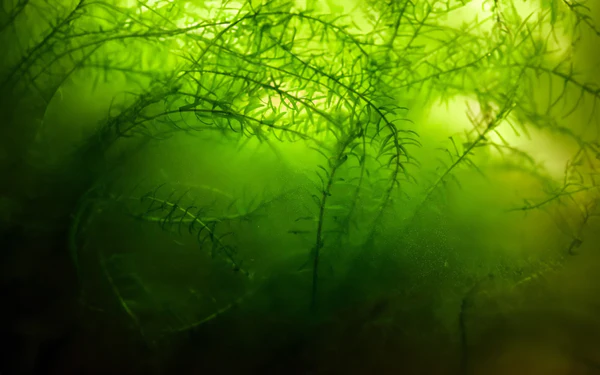Ways to Clean Algae from Your Fish Tank
Algae, while natural and beneficial in moderation, can become unwelcome when it accumulates excessively in an aquarium, obstructing visibility and hindering plant growth.

By implementing these methods, you can effectively combat algae growth and maintain a clean and healthy aquarium environment for your fish and plants.
- Algae Scraper:
- Choose an algae scraper suitable for your aquarium size and material (plastic or magnetic for glass/acrylic tanks).
- Start from the top of the glass and work your way down, using gentle but firm strokes to remove algae buildup.
- Be careful not to press too hard, especially on acrylic tanks, to avoid scratching the surface.
- Rinse the scraper frequently to prevent spreading algae spores.
- Algae Brush:
- Select an algae brush with stiff bristles to effectively scrub away algae from decorations, rocks, and other surfaces.
- Brush in a circular motion to dislodge algae, paying attention to crevices and hard-to-reach areas.
- Use caution with delicate decorations to avoid damage; softer brushes or brushes with softer bristles may be suitable for fragile items.
(Twirl a toothbrush in a mass of hair algae to easily detach it from plants, hardscape, or fish tank decor.)
- Algae-eating Fish and Invertebrates:
- Research and select algae-eating fish species or invertebrates compatible with your aquarium’s size and inhabitants.
- Introduce species such as plecos, otocinclus catfish, Siamese algae eaters, nerite snails, or Amano shrimp to graze on algae-covered surfaces.
-
- Top of FormEnsure proper care and provide a balanced diet to maintain the health and activity of algae-eating species.
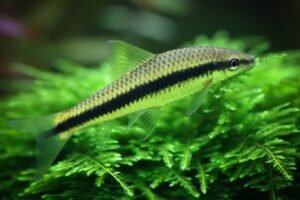
(The Siamese algae eater is an excellent clean-up crew member for bigger fish tanks, but make sure not to accidentally get its more aggressive lookalike, the Chinese algae eater.)- Chemical Treatments:
- Choose algae control products or algaecides appropriate for your aquarium type (freshwater or saltwater) and algae species.
- Follow manufacturer instructions carefully, dosing according to your tank’s volume and algae severity.
- Consider temporary removal of sensitive inhabitants or plants during treatment to minimize stress or potential harm.
- Monitor water parameters closely following treatment and perform water changes as needed to maintain water quality.
- Chemical treatments are listed last because they’re most effective after balancing lighting and nutrients in a planted aquarium. Using algaecides without addressing these factors may lead to recurring algae growth. For more tips on fighting algae, check out our article on the six most common types of algae.
- Chemical Treatments:
- Water Changes and Maintenance:
- Establish a regular maintenance routine, including weekly water changes of 20-30% to remove excess nutrients and algae spores.
- Vacuum substrate to eliminate organic debris and detritus, which contribute to algae growth.
- Trim and prune live plants to prevent shading and improve water circulation, reducing algae-friendly conditions.
- Monitor and adjust lighting intensity and duration to discourage algae proliferation while meeting the needs of aquatic plants.

(Easy Carbon is effective against persistent algae outbreaks like BBA. When directly applying the chemical, temporarily turn off the filter to allow the treatment to “soak” on the algae for a few minutes.)
By incorporating these methods into your aquarium maintenance routine, you can effectively combat algae growth and maintain a clean and thriving aquatic environment.
How to Clear Up a Cloudy Fish Tank
Cloudy water can indeed be frustrating for aquarium enthusiasts, hindering the enjoyment of their beautiful fish tanks. In this article, we delve into the various reasons behind aquarium haziness and provide tips for restoring clarity swiftly.
To begin addressing cloudy water, start by transferring a sample of the tank water into a solid white plastic cup or bucket. This allows for closer examination of the water’s color and cloudiness without any interference.
Particles in the water
If you’re noticing specks or particles in your aquarium water, the cloudiness is likely caused by various factors such as fish waste, excess food, dusty substrate, or other debris. During tank setup or planting, tiny substrate particles may float into the water column, settling or getting collected by the filter over time. However, persistent haziness may require multiple large water changes or thorough substrate rinsing to remove lingering silt.
Regular tank maintenance is essential for keeping water consistently clean and clear. Use an aquarium siphon to vacuum the substrate and perform water changes to remove excess waste. Additionally, clean the filter monthly to prevent debris buildup, ensuring it can effectively remove particles from the water.
If murky water persists despite regular cleaning, consider the type of food you’re feeding your fish. Messy foods can lead to dusty fish waste, contributing to cloudiness. Opt for cleaner foods like live or single-ingredient frozen options to minimize waste production.
Bottom feeders like eartheaters can stir up substrate, perpetuating cloudiness. Increasing mechanical filtration can help by physically straining out debris from the water. Various filter types, such as hang-on-back, canister, undergravel, and sponge filters, aid in mechanical filtration. Consider adding prefilter sponges and coarse sponge pads to trap larger particles, along with fine poly pads to capture smaller ones. Improve water circulation with power heads to eliminate dead spots and ensure loose particles are captured by the filter.
Water clarifiers can also be used to clear up cloudy water caused by debris. These products bond with suspended particles, causing them to clump together for easier filtration. Note that water may appear worse initially as the clarifier works, but clarity should improve as the filter collects debris.
Bacterial bloom
If your tank water appears like diluted milk when viewed in a white cup, you may be experiencing a bacterial bloom. This occurs when there’s an excess of nutrients in the water and insufficient beneficial bacteria to consume them, leading to a rapid increase in bacterial population. The result is water that resembles a milky consistency.
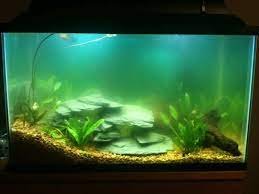
Bacterial blooms commonly occur during aquarium cycling or when a large number of fish are added suddenly, as the ecosystem lacks sufficient beneficial bacteria to support the increased nutrient load. They can also arise if a significant portion of beneficial bacteria is removed or killed, such as through repeated large water changes, overcleaning of filters, or use of certain medications harmful to beneficial bacteria.
The solution to a bacterial bloom is simple: patience. Avoid adding UV sterilizers or conducting excessive water changes to remove haziness, as these actions may prolong the bloom. Instead, allow one to two weeks for the water to clear naturally as the bacterial population reestablishes itself. This approach allows the aquarium ecosystem to balance out without interference.
Green water
If the water in your white cup has a green tint or your aquarium resembles pea soup, you’re likely dealing with an algae bloom. Green water is caused by tiny, free-floating algae and can be beneficial for raising baby fish due to the abundance of microscopic food it provides. However, it obstructs visibility into the aquarium and may hinder plant growth by blocking light.
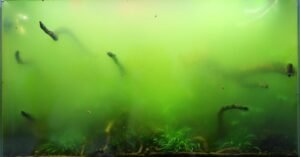
Algae blooms typically result from an excess of light and nutrients, often originating from overfeeding, fish waste, and fertilizer usage. Similar to bacterial blooms, fine filter floss and extensive water changes are ineffective in removing green water. Some aquarists suggest a blackout method, involving turning off the aquarium light, covering the tank with a blanket for 7 to 10 days, and then performing water changes to remove dead algae. However, this approach may harm plants and potentially lead to ammonia spikes.Alternatively, using a UV sterilizer is recommended for treating green water. UV sterilizers alter the cell structure of algae, preventing reproduction. Following sterilization, multiple water changes can be performed to clear the green water, restoring clarity to the aquarium. This method is effective and minimizes the risk of harm to plants or fish caused by light deprivation or ammonia spikes.
Brown water
When your aquarium water exhibits a brown tinge, it’s often due to tannins, an organic compound naturally present in catappa leaves, driftwood, and other botanical materials. While tannins are utilized to create blackwater environments favored by certain fish species, many aquarists prefer clear water aesthetics.
To gradually remove brown water, manual water changes can be effective, provided additional tannin sources are not introduced. Soaking or boiling new driftwood can expedite the leaching of tannins. If these methods prove ineffective, consider employing chemical filtration using activated carbon in a filter bag, carbon pads, or products like Seachem Purigen in a hang-on-back or canister filter. Activated carbon becomes saturated with tannins and toxins over time and must be replaced, whereas Purigen is reusable and can be regenerated with bleach to remove accumulated impurities.
Cloudy aquarium wallsTop of Form
If the water in your white cup appears clear but the tank itself seems cloudy, the issue may lie with the aquarium walls. Ensure clarity by following these steps:
- Clean the Inside: Scrub the interior walls of the aquarium with an algae scraper to remove any buildup or residue that could be causing haziness.
- Wipe the Outside: Use an aquarium-safe cleaner to wipe the exterior of the tank, removing any dust, fingerprints, or smudges that may be affecting visibility. If you have an acrylic aquarium, ensure the cleaner and scraper are acrylic-safe to prevent micro-scratches.
- Address Glare: Sometimes, glare from surrounding lights can create the illusion of haziness. Consider adding an aquarium background on either the inside or outside of the tank to reduce glare and improve clarity.
By thoroughly cleaning the aquarium walls and addressing potential sources of glare, you can ensure optimal visibility and enjoyment of your aquarium.
Reasons Why Your Aquarium Water Has Bubbles or Foaming
As we seen bubbles or foam in aquarium water, and it’s essential to understand their potential causes and whether they pose any risk to fish. Let’s explore the reasons behind bubbles and foam in aquariums and how to address them:
- Good Reasons for Bubbles:
- Aeration: Bubbles may occur due to aeration devices such as air stones, airstrips, or air pumps. These bubbles help increase oxygen levels in the water, which is beneficial for fish and other aquatic inhabitants.
- Agitation: Water agitation from filters or water movement devices can also create bubbles. This agitation helps maintain water circulation and oxygenation.
- Bad Reasons for Bubbles:
- Dissolved Organic Compounds: Excessive organic matter, such as fish waste, uneaten food, or decaying plant material, can produce bubbles or foam. This indicates a buildup of dissolved organic compounds, which can degrade water quality and harm fish if left unchecked.
- Detergents or Contaminants: Introduction of detergents, soaps, or other contaminants into the aquarium water can lead to the formation of bubbles or foam. These substances are harmful to fish and should be avoided at all costs.
- Addressing Bubbles and Foam:
- Regular Water Changes: Perform regular water changes to remove dissolved organic compounds and maintain water quality.
- Proper Filtration: Ensure adequate filtration to remove debris and organic matter from the water column.
- Avoid Contaminants: Prevent the introduction of detergents, soaps, or other contaminants into the aquarium water.
- Check Water Parameters: Monitor water parameters such as ammonia, nitrite, nitrate, and pH to ensure they are within acceptable ranges.
- Observe Fish Behavior: Watch for signs of distress or illness in fish, such as gasping at the surface or lethargy, which may indicate poor water quality associated with excessive bubbles or foam.
By understanding the potential causes of bubbles and foam in aquarium water and taking appropriate measures to address them, you can ensure a safe and healthy environment for your fish.
Normal bubbles from an air pump
Absolutely, bubbles generated by an air pump are a common occurrence in aquariums. When using an air pump, it draws in air from outside the aquarium, pumps it through airline tubing, and releases it into the water through various air-driven devices such as air stones, sponge filters, bubblers, or decorations.
These bubbles are typically transparent and serve to increase oxygen levels in the water, benefiting fish and other aquatic organisms. They should pop immediately upon reaching the water surface, contributing to aeration and water circulation.
In high-tech planted tanks where CO2 injection is utilized, another source of bubbles may be present. CO2 diffusers are often used to break up the CO2 gas into tiny bubbles, facilitating its dissolution into the water. These bubbles aid in providing carbon dioxide to aquatic plants for photosynthesis, promoting healthy plant growth.
Micro bubbles after water changes
Micro bubbles appearing in the aquarium after a water change can be a common occurrence, especially during colder months. When cold water from underground pipes is warmed by a water heater to match the tropical aquarium’s temperature, dissolved gases are released into the water, forming tiny bubbles on various surfaces such as glass, substrate, plants, and decorations.
This phenomenon is typically harmless, and most of the bubbles should dissipate within a few hours. However, if an unusually high number of bubbles persist on the glass, it may indicate a significant temperature difference and water volume replacement during the water change.
While this occurrence isn’t typically cause for concern, it’s essential to monitor the aquarium closely in the hours and days following a water change. Large water changes can lead to fluctuations in water parameters, potentially impacting fish health. By observing the tank closely, any adverse effects on fish can be addressed promptly.
Fish medicines or chemicals

Indeed, certain fish medications or chemicals can cause foaming in the aquarium water by altering its viscosity or thickness. When using these medications, bubbles may form and persist longer than usual, especially if there’s agitation from an air stone or sponge filter in the tank.
Foam resulting from fish medications typically consists of clear, transparent bubbles. However, if the bubbles exhibit an oily, iridescent sheen, it may indicate contamination from soap or other cleaning products, which can be highly detrimental to fish.
To mitigate the risk of contamination, it’s crucial to handle cleaning products with care and avoid introducing them into the aquarium water. When cleaning aquarium items, rinsing with water is often sufficient. If disinfection is necessary, soaking or washing items with a diluted bleach solution, followed by thorough rinsing with clean water, is recommended. Ensure that all items are completely air-dried before reintroducing them to the aquarium to prevent any potential harm to fish or other aquatic life.
Oil slick on the water surface
If you observe a gooey, translucent biofilm on the water surface of your aquarium, it’s likely caused by organic compounds such as oils from fish foods, residues from your hands, or other substances present in the water. This biofilm can trap bubbles that would normally rise and pop at the surface, contributing to its appearance.
While some hobbyists may attempt to remove the biofilm with a paper towel, this is only a temporary solution. The underlying issue is a lack of surface agitation and proper gas exchange, which are essential for oxygenating the water to support fish health.
To address this problem, consider the following steps:
- Surface Agitation: Use a sponge filter or adjust the output of your existing filter to create bubbles that agitate the water surface. This agitation helps to break up the biofilm and promote gas exchange.
- Remove Floating Plants: If overgrown floating plants are hindering surface agitation, consider trimming or removing them from the aquarium. This allows for better water movement and oxygen exchange at the surface.
- Maintain Water Quality: Regular maintenance, including partial water changes and cleaning of filter media, can help prevent the buildup of organic compounds that contribute to biofilm formation.
By promoting surface agitation and ensuring proper gas exchange, you can effectively dissipate the oil slick and create a healthier environment for your aquarium inhabitants
Excess ammonia
Excess ammonia in an aquarium can indeed lead to foaming in the water, similar to what you might observe in natural waterways affected by animal waste runoff. Ammonia buildup can occur due to various factors, including overstocking, overfeeding, or the decomposition of organic matter such as leaves and debris.
Foaming caused by excess ammonia is typically noticeable when there’s agitation in the water, such as from a sponge filter or other bubble-producing equipment. If you observe unusual foaming in your aquarium and suspect ammonia as the culprit, it’s essential to test the water using ammonia test strips or a multi-test kit to confirm the levels of ammonia and other potentially harmful chemicals.
To address excess ammonia and mitigate foaming, consider the following steps:
- Water Testing: Use ammonia test strips or a multi-test kit to measure the levels of ammonia in the water. This will provide valuable information about the extent of the issue and help guide corrective actions.
- Water Changes: Perform partial water changes to dilute ammonia concentrations and improve water quality. Regular water changes help remove accumulated waste and replenish essential nutrients.
- Reduce Feeding: Adjust feeding habits to prevent overfeeding, which can contribute to ammonia buildup. Feed fish sparingly and remove any uneaten food promptly to prevent excess waste from decomposing in the aquarium.
- Increase Aeration: Enhance aeration and water circulation in the aquarium to promote gas exchange and oxygenation. This helps alleviate stress on fish and other aquatic inhabitants caused by high ammonia levels.
By addressing excess ammonia and maintaining optimal water quality, you can prevent foaming and create a healthier environment for your aquarium inhabitants. Regular monitoring and proactive measures are key to preventing ammonia-related issues in the aquarium.
Bubble nests
Bubble nests are fascinating structures created by certain species of fish, notably bettas, gouramis, and other bubble nesters. These nests are meticulously constructed by male fish using bubbles produced from their saliva. The bubbles are gathered and piled together in a specific location, often in a tranquil corner of the aquarium or near a floating plant where there’s minimal surface agitation.
Male fish build bubble nests as part of their reproductive behavior. During breeding season, the male will court the female and entice her to spawn. After mating, the female releases eggs, which the male collects in his mouth and spits into the bubble nest. He then guards the nest diligently, ensuring the safety of the eggs until they hatch. Once the eggs hatch, the male continues to protect and care for the young fry until they become free-swimming.
Bubble nests serve as a crucial component of the breeding process for these species, providing a safe and protected environment for the development of the offspring. If a bubble nest is accidentally disturbed during maintenance or water changes, males will often rebuild new nests as needed, demonstrating their instinctual drive to care for their young.
pearling plants
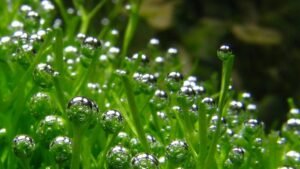
Pearling plants, a phenomenon observed in aquariums, occur when plants undergo photosynthesis, particularly during the daytime. During photosynthesis, plants absorb light and carbon dioxide while releasing oxygen. When the water becomes oversaturated with dissolved oxygen due to the photosynthetic activity of plants, excess oxygen is released from the plant’s leaves in the form of tiny bubbles. These bubbles are visible as they rise to the water’s surface.
The term “pearling” describes this process, likening the appearance of bubbles on the plant leaves to pearls. Pearling is a sign of healthy and active plant growth, indicating that the plants are thriving and producing oxygen as a byproduct of photosynthesis.
In addition to plants, algae can also contribute to pearling in aquariums. While algae may not always be aesthetically pleasing, they also undergo photosynthesis and release oxygen into the water. This oxygenation is beneficial for the overall aquarium ecosystem, providing fish with essential oxygen for respiration and helping to absorb nitrogenous waste compounds produced by fish and other organisms.
Overall, pearling plants and algae play important roles in maintaining water quality and supporting aquatic life in the aquarium.
Aquarium Salt: When and How to Use It Properly
The use of aquarium salt in freshwater tanks is a topic of debate among aquarists. Some advocate for its regular use to provide fish with essential electrolytes, while others view it primarily as a treatment for diseases. Through extensive testing with numerous fish species, the efficacy of salt, specifically sodium chloride (NaCl), has been demonstrated in combating bacteria, fungus, and external parasites.
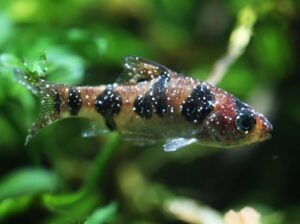
There are several advantages to using aquarium salt. It is inexpensive, widely available, has an indefinite shelf life, and can be utilized across a range of concentrations. However, there are also drawbacks to consider. Different fish species have varying tolerance levels to salt, making it challenging to determine the appropriate dosage for each species. Additionally, salt is not compatible with most live plants and snails. Accidental overdosing of salt can be detrimental, potentially harming or even killing aquarium inhabitants.
For these reasons, some aquarists prefer to use alternative medications or treatments. However, with precise measurements and cautious application, both novice and experienced fish keepers can effectively utilize aquarium salt as a versatile and potent remedy in freshwater aquariums.
How does aquarium salt work?
Indeed, salt’s mechanism of action in combating pathogens in freshwater aquariums is primarily through dehydration. By increasing the salinity of the water, salt disrupts the osmotic balance within microorganisms such as bacteria, fungus, and parasites. Osmosis seeks to equalize the concentration of salt on both sides of the microorganism’s membrane or skin, causing water to be drawn out of the pathogen’s cells.
As a result, these microorganisms undergo dehydration at a faster rate than fish, as fish possess more mass and stored water. Consequently, the pathogens perish before their hosts are affected. However, it’s essential to note that some microorganisms may possess greater tolerance to higher salinity levels, rendering salt treatment less effective against certain pathogens.
While salt can be highly effective in many cases, it’s important to recognize that it is not a universally guaranteed solution for all aquarium ailments. Understanding the limitations and potential risks associated with salt treatment is crucial for responsible and effective aquarium management. Additionally, considering alternative treatments or consulting with experienced aquarists or veterinarians may be necessary for addressing specific issues in the aquarium environment.
Should I use salt all the time
Exactly, using sodium chloride salt as a daily preventative measure or health booster in freshwater aquariums is not recommended. Employing salt in such a manner can lead to the development of resistant pathogens, akin to the misuse of antibiotics in humans. Just as overuse of antibiotics can breed antibiotic-resistant bacteria, continuous exposure to salt may result in the emergence of resilient fish diseases that require higher salt concentrations for treatment.
Instead, it is advisable to use salt sparingly and only when necessary. By doing so, salt remains a potent tool in combating specific ailments in the aquarium, without risking the development of resistance or causing harm to the fish. This approach ensures that salt remains an effective treatment option when needed, while minimizing the potential drawbacks associated with its excessive or indiscriminate use.
How to use salt as a medication
It’s important to clarify that when discussing the use of salt in freshwater aquariums, we are specifically referring to normal aquarium salt or sodium chloride (NaCl) rock salt. This type of salt is distinct from table salt, marine salt, or Epsom salt, each of which has different chemical compositions and may not be suitable for aquarium use.
In our method of treatment, we begin with the lowest level of salt and incrementally increase the dosage if symptoms persist. It’s crucial to adhere to proper measurement standards, with the following references applying to United States (US) customary units rather than the UK imperial system. This systematic approach ensures that salt is used effectively and safely in freshwater aquariums, minimizing potential risks to aquatic life while addressing specific health concerns.
Level 1 Treatment:
- Add 1 tablespoon (Tbsp) of salt per 3 gallons of water.
- This concentration is akin to using Neosporin topical ointment for a small cut and is effective against mild cases of bacterial and fungal infection.
- It gently irritates the fish’s slime coat, prompting the production of beneficial mucus that can impede parasites and microorganisms.
- Safe for most fish species, except anchor catfish.
- Maintain the fish in the salt solution for 4 to 5 days before considering an increase in concentration.
Level 2 Treatment:
- Utilize 1 Tbsp of salt per 2 gallons of water for a broader range of illnesses.
- Effective for treating common ailments like ich (white spot disease) over a period of 10 days.
- If symptoms worsen after 5 days, consider elevating the concentration.
Level 3 Treatment:
- Increase the concentration to 1 Tbsp of salt per gallon of water for stubborn cases that do not respond to medications or lower salt levels.
- Exercise caution with scaleless fish and sensitive species, as this potent solution may be harsh on them.
- Research the salt tolerance of specific species beforehand.
- While many species, including rasboras, tetras, and cichlids, are fairly salt-tolerant, some may be more sensitive.
- Remember that aquarium salt does not evaporate or get filtered out, so only add salt during water changes to maintain the desired concentration.
- Measure salt carefully to avoid overdosing, as salt does not break down over time.
How long should the salt treatment last
After administering salt treatment, monitor the fish closely until signs of health are observed, then proceed with the following steps:
- Salt Removal: Leave the salt in the aquarium until the fish appears healthy, then remove the salt by performing water changes.
- Post-Treatment Water Changes: At the end of treatment, conduct a 30% water change without adding any salt. Wait for a week and observe the fish.
- Observation Period: If the disease does not recur during this time, perform another 30% water change without replacing the salt. Wait for another week and monitor the fish for any signs of illness.
- Disease Recurrence: If the disease returns, return to the original salt concentration and increase the solution strength slightly. The initial salt concentration may not have been potent enough to fully eradicate the illness, or the fish may not have been exposed to the salt solution for a sufficient duration to dehydrate all pathogens.
Can I use salt for fish in quarantine
Yes, you can use salt for fish in quarantine. Treating new fish with a low salt dosage, such as the level 1 treatment, for a period of two weeks can help eradicate approximately 60% of potential illnesses. This method can also be utilized to aid in the recovery of fish that have been injured or stressed and require solitary recovery time in a hospital tank.
While opting for fish medication may appear to be the simplest solution, salt is notable for its effectiveness in treating undiagnosed or mystery diseases that may be challenging to identify. Additionally, some countries are imposing restrictions on the sale of antibiotics and other drugs used in the pet trade to mitigate risks to human and environmental health. Consequently, aquarium salt may emerge as a valuable resource for treating sick fish in the future.
- Top of FormEnsure proper care and provide a balanced diet to maintain the health and activity of algae-eating species.


